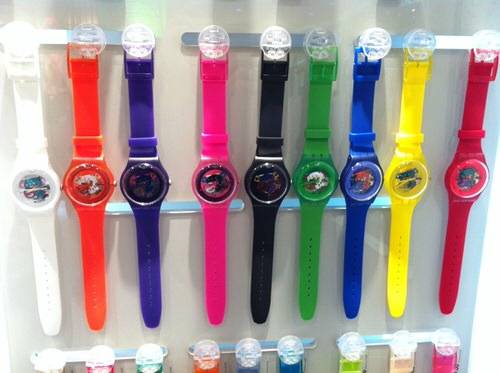Swatch, a giant in plastic wristwatches circa 1983, has a plan to recapture our hearts and wrists, but in a distinctly newfangled way. According to a recent Bloomberg report, the Swiss watchmaker will release its first smartwatch this spring.
The launch window would seem to pit the Swatch wearable against the Apple Watch, coming in April. At least, that’s the popular narrative building around the new SmartSwatch (or whatever it’s called).
See also: The Apple Watch Is Coming In April
But the notion is flawed, to say the least. Based on the details, the two devices won’t be in direct competition with each other, so Apple has nothing to worry about from the Swiss watchmaker.
Pebble, on the other hand, does.
Pitching Apples

When Swatch watches burst onto the scene, big hair and Duran Duran ruled the world. Over the years, it remained a popular brand for analog timepieces, but couldn’t quite make up its mind about its next stage of evolution.
CEO Nick Hayek Jr. has flip-flopped on connected watches. While introducing a wrist-based two-way communicator called Swatch Talk in 2000, he told the New York Times that “the Internet watch will be even more successful than the mobile.” Then two years ago, he essentially dismissed the smartwatch’s prospects, only to state last year that his company was working on one for release this year.
Assuming he sticks with the current plan, Swatch will become the latest to join the ranks of Timex, Fossil, Tag Heuer and Montblanc—all noted watchmakers who have all announced or released their own high-tech wristwear. So, of course, have many of the world’s major tech companies.
Prior to Apple’s own smartwatch announcement last fall, in fact, rumors circulated that it was collaborating with Swatch on a wrist gadget. Hayek denied it last year, when he outed his company’s own plans to go it alone.
It makes for juicy context. So does the fact that Swatch reportedly also plans to support mobile payments, possibly with its own system—a category that Apple Pay helped popularize.
So the setting seems ripe for a skirmish between tech giant Apple and Swatch, the wristwatch heavyweight, duking it out in a wearables arena. Headlines like this, this and this suggest as much. Too bad it’s all hogwash.

Most smartwatches must pair to mobile devices, so their target users are narrowly defined as users of specific smartphone platforms. According to Hayek, the Swatch device will only support Android and Windows. Part of the reason may go back to the way the SmartSwatch will connect to phones. Instead of typical Bluetooth pairing, Swatch will use the short-range wireless technology Near Field Communication.
The latest iPhones support NFC, and the Apple Watch will as well—but for Apple Pay’s tap-to-pay feature. Apple hasn’t yet allowed any other use of its NFC technology, which nixes any chance that Swatch could somehow tie into it.
The bottom line: This SmartSwatch cannot possibly compete against Apple’s own watch when it comes to iOS users.
Bumps In The Road For Pebble
Pebble and Swatch, however, have more in common.

Pebble works with both iOS and Android, the latter a crucial target customer for Swatch. They also share similar brand identities. The Swatch name is mostly associated with affordable, plasticky watches sold in a range of styles and colors. In the realm of smartwatches, that’s Pebble’s jam.
Swatch will likely release its smart wearable under its own name, rather than one of its premium product lines. (It owns Omega, Longines, Rado, Tissot and Blancpain.) Luxury tech is hard to pull off credibly, and it’s tough to see the company risking the reputation of its higher-ticket brands with an unproven gadget category—especially one it keeps changing its mind about.
Not that the company lacks the experience to pull it off. Swatch learned about the challenges of stuffing components into a small body with the Swatch Talk, and now it produces the Swatch Touch—a touchscreen watch that will soon offer fitness features as well. (Its upcoming wearable will also support step tracking and other related features.)
Swatch is well-versed in sensor technology, and it holds a bevy of patents—including one for a thin, flexible battery “that can double performance,” Hayek told Bloomberg.
See also: Pebble: It’s A Real Fitness Tracker Now And Cheaper, At $99
Both areas plant Swatch firmly in Pebble’s territory. The startup just released built-in fitness features last fall, along with bright new colors and price cuts that slashed the original plastic Pebble from $149 to $99. (Pebble Steel’s $249 price tag dropped to $199.) As for battery life, Pebble’s 5–7 day longevity beats the typical 1–2 day range for smartwatches, thanks to its e-paper display and physical buttons.
According to Hayek, the new Swatch device won’t require charging—though he also said his fancy battery tech won’t be available until later models. However, if they live up to the promise, especially with a touchscreen on board, that could undercut one of the primary reasons people choose Pebbles.
Another is app selection. Pebble offers about 6,000 apps in its watch app store, which opened early last year. Swatch won’t come anywhere near that for quite some time. However, Pebble just announced “a new platform” of some sort for later this year, which could level the development playing field.
In other words, Pebble may want to watch out. Swatch is no upstart, and though its smartwatch intentions flopped around before, now it may have finally gotten the fit right.
Swatch photos by Choo Chin Nian (lead photo, Swatches and box photo); Apple Watch photo courtesy of Apple; Pebble photo by Adriana Lee for ReadWrite

















